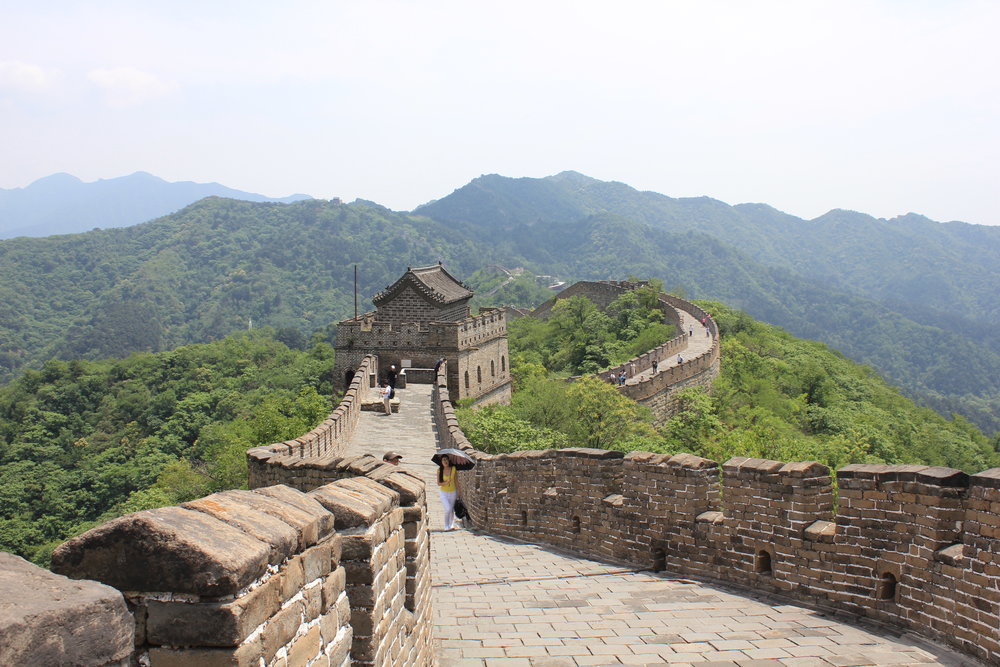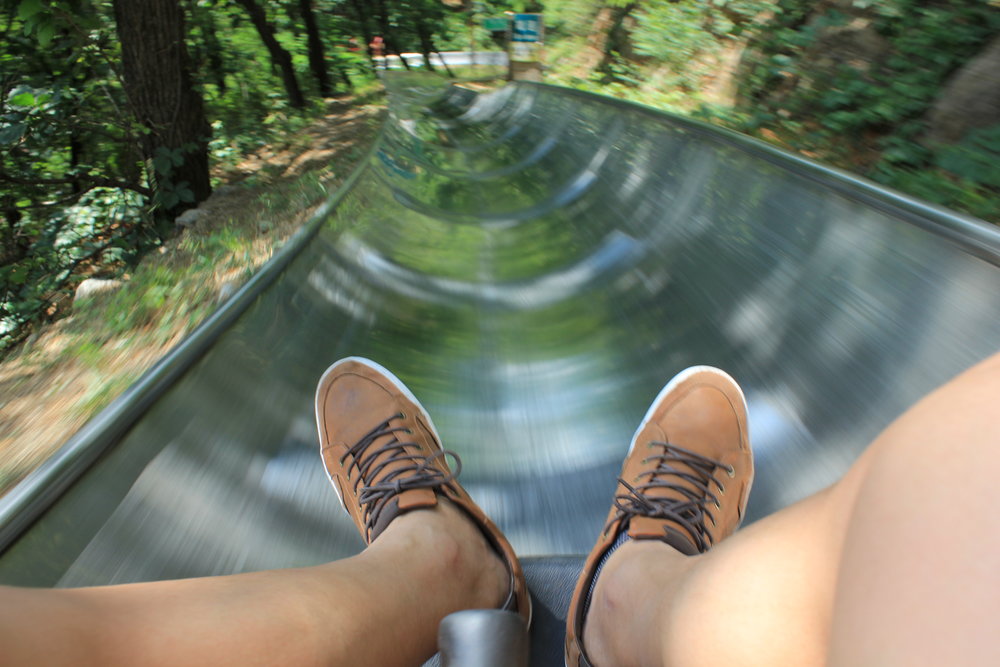A trip to Beijing is always special for me, given that I had spent the majority of my childhood in the Chinese capital. Ever since I left for university in Toronto, I’ve made quite a few trips back home to visit my family, and each time I’m stunned by the vast changes that seem to have taken place in the blink of an eye.
From the demolition of bars and pubs of old, to skyscrapers sprouting up like gigantic bamboo shoots in the concrete jungle, to the overnight emergence of thousands of mobile grab-and-go bicycles, the sheer pace of change in China means that there’s always lots of new stuff to discover whenever I come home.
Our trip in May was no exception. Jessica and I spent about a week in Beijing, mostly relaxing at home following the previous week of whirlwind round-the-world travel, but also taking in some of the capital’s unmissable points of interest.
The highlight of our week was no doubt our trip to the Mutianyu section of the Great Wall of China. It’s one of the most well-preserved sections of the Wall and dates back to the mid-6th century. It’s located about a two-hour drive north-northeast of downtown Beijing.
The Great Wall was built, destroyed, and restored over the course of many centuries in ancient China, with the first bricks having been laid down as early as the 7th century BC. The Wall stood along the historical northern borders of the Chinese civilization to guard against the nomadic people of the Eurasian Steppe. It’s an absolute must-see destination for any trip to Beijing.
The general advice for Mutianyu (and how my family has always done it) is to get on the road early, arrive at around 9 or 10 in the morning, climb the Wall for a couple of hours, and then come down for a nice local lunch.
This allows you to be back in town for the afternoon; you can then rest your legs and schedule something else for the evening. The alternative is to do an afternoon trip to the Great Wall, though the heat can get overbearing in the summer.
And of course, if you’re serious about it, you can spend the whole day on the Wall and climb all the way out to the farthest reaches on this section, and beyond.
Mutianyu Great Wall used to be much more of a “diamond in the rough” when it came to the sections of the Wall in Beijing’s outskirts. In recent years, though, they’ve cleaned it up a lot and made things much more tourist-friendly, which can be a good or bad thing depending on how you look at it.
Upon arriving at Mutianyu, visitors park at an entrance facility (if you’re coming with a driver, you’ll be dropped off here). This is where you buy your admission tickets; from here, buses transport visitors up some winding mountain roads to a “base camp” of sorts.

Mutianyu Great Wall – Main entrance
You used to be able to drive up to the base camp on your own, though they added the entrance facility further downhill, presumably to allow many more shops, vendors, and restaurants to capitalize on the growing tourism here at the Mutianyu section.
The base camp is where all the action takes place, though. There are three ways to get up to the Great Wall, which you are more than welcome to mix-and-match for your uphill and downhill journeys. You can hike up the 2,000 or so steps on your own. Or you can take the regular cable car, which brings you up there in about ten minutes.
OR – and this is what makes Mutianyu truly special – you can “chairlift up, toboggan down”. This is exactly what it sounds like: you’re transported up the hill using a two-person chairlift, and when you’re done climbing the steps on the Great Wall, you slide down on a winding metal slide system, using specially-designed personal toboggans.

Mutianyu Great Wall – Chairlift
Naturally, whenever we visit Mutianyu, we go with the chairlift and toboggan option. I’ve never seen anything like it anywhere else to be honest, and it feels like it’s one of those “crazy boardroom ideas” that somehow made it into reality.
It’s simply the most awesome way to get up and down the hill, and sliding down at full speed, after a long day climbing the Great Wall, feels epic in particular. It’s all designed brilliantly as well, in that the chairlift ride provides panoramic birds-eye views of the toboggan ride you’ll be cruising down later on.

Mutianyu Great Wall – View of toboggan slide from chairlift

Mutianyu Great Wall – View of toboggan slide from chairlift
Once you’re up on the Wall, you’re free to spend as much time as you’d like climbing the steps. The Mutianyu section is about 2,250m long, so a full climb takes quite a few hours to complete. Many visitors climb a portion of the way across and turn back before reaching the end.

Mutianyu Great Wall
The views are breathtaking, and it’s difficult not to be struck by the notion that generations upon generations of workers in ancient China had to lay the brickwork for this entire fortification, stretching thousands of miles into the distance, by hand.


Keep in mind that the Great Wall is nothing but endless steps, many of which are quite steep and have become quite slippery over the years under the footsteps of millions of tourists, so make sure you get your footwear right – sneakers required!

Mutianyu Great Wall
The watchtowers on this section of the Wall are aplenty and offer some respite from the heat. Stop here to catch your breath and admire the views from the lookouts.

Mutianyu Great Wall – Watchtowers

Mutianyu Great Wall – View from watchtower lookout
If you want to go off the beaten path and explore parts of the Great Wall that haven’t been restored as much, just keep going west on the Mutianyu section. Eventually you’ll come to a large wall that’s been erected there to discourage access. Scale this obstacle and you’ll find yourself on a whole other Great Wall – the crumbling original stonework that’s covered in loose rock and overgrown bushes.
Cell phone service drops off sharply around these parts, and the area is remote and very thinly populated, so make sure you can take care of yourself in the case of an emergency, especially if you decide to venture further along the “wild wall”.
When you’re ready to go back down the mountain, that’s when the real fun begins! Get comfortable on your toboggan because you’ll be zooming downhill on these four wheels. Hold on tightly to the lever, push forward to accelerate, and pull back to brake.

Mutianyu Great Wall – Toboggan starting point

Mutianyu Great Wall – Toboggans
Depending on how fast you go, it takes about two to three minutes to slide all the way down, and you get some breathtaking views along the way. But resist the temptation to slow to a halt and take pictures, unless you want to get an earful from the dozen or so guards patrolling the hillside!

Mutianyu Great Wall – Tobogganing downhill

Mutianyu Great Wall – Tobogganing downhill
After an exhilarating descent, you’ll find yourself back at “base camp”, and from there it’s back on the bus to get to the main facility further downhill. There’s Starbucks and Burger King here, but I’d really recommend grabbing lunch at one of the local restaurants and trying the barbecued rainbow trout, a delicious Mutianyu area specialty.

Mutianyu Great Wall – Rainbow trout
Is Mutianyu the best section of the Great Wall to visit if you’re in Beijing? Well, it’s certainly much less crowded and hectic than the Badaling section, which is where all those photos of tourists packed like cattle on the Great Wall were taken. However, in recent years, many tour companies have used this as a selling point to begin operating their Great Wall tours in Mutianyu, slowly chipping away at this advantage.
The fact that a purpose-built commercial facility has been built at the base of the mountain is further evidence that Mutianyu may very well get overrun by tourists in the near future, just like Badaling. If you’ve got a visit to Beijing planned anytime soon, now’s the time to hit up the Mutianyu Great Wall before the crowds take over.
Conclusion
A day out at the Mutianyu Great Wall should be at the top of your list for your stay in Beijing, and I highly recommend it for everyone. Absolutely nothing compares to seeing the Great Wall of China for yourself, and of course the toboggan ride at the end is the icing on the cake.
















Hi there! I’ve been trying to find out how long it takes to get to this part of the wall from Beijing. I’ve not had any luck. What’s the best way to get there and how lucky by does it take? I’ll be going in August!
Hi Mandy,
It’s about a 1.5 – 2 hour drive by car. If you’re visiting Beijing, the best way would probably to coordinate with your hotel to find a driver who can take you.
Hi Ricky! This a nicely written piece about the Mutianyu section of the wall. Btw, may I know the date you’ve been here? The scene is refreshingly good and less people hiking. Thanks.
Hey Mharj,
This was in May 2017. As long as you depart as early as possible and arrive on the wall around 9am, your visit should be relatively crowd-free!